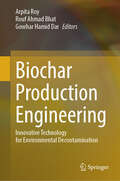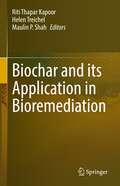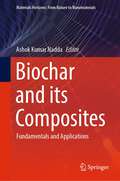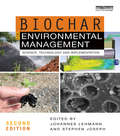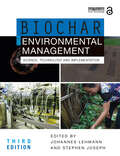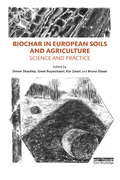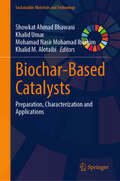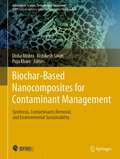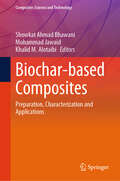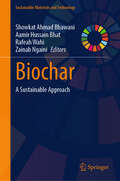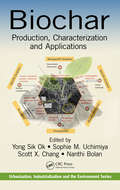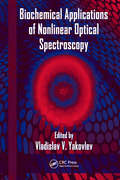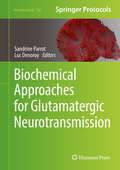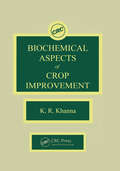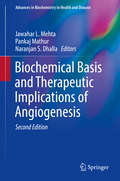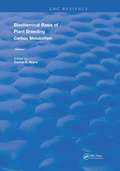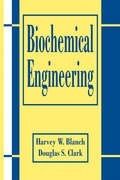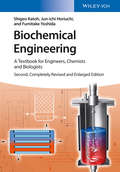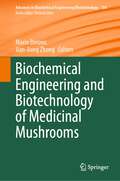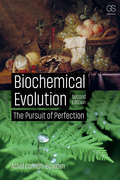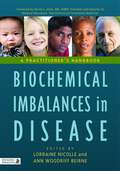- Table View
- List View
Biochar Applications in Agriculture and Environment Management
by Jay Shankar Singh Chhatarpal SinghThis book provides up-to-date information on biochar use in management of soil health, agriculture productivity, green-house gases, restoration ecology and environment. Biochar application to nutrient deficient and disturbed soils is a viable option which may promotes advances in food safety and food security to human nutrition and overall fundamental research in the agricultural sciences. The book describes in detail how the recalcitrant biochar is able to persist for long periods of time and work as a shelter for soil microbial colonisation and their biomass/numbers. This book also includes contents related to important role of biochar applications in the restoration of contaminated agricultural soils. The book will be of particular interest to students, teachers and researchers in the disciplines.
Biochar Applications in Agriculture and Environment Management
by Jay Shankar Singh Chhatarpal SinghThis book provides up-to-date information on biochar use in management of soil health, agriculture productivity, green-house gases, restoration ecology and environment. Biochar application to nutrient deficient and disturbed soils is a viable option which may promotes advances in food safety and food security to human nutrition and overall fundamental research in the agricultural sciences. The book describes in detail how the recalcitrant biochar is able to persist for long periods of time and work as a shelter for soil microbial colonisation and their biomass/numbers. This book also includes contents related to important role of biochar applications in the restoration of contaminated agricultural soils. The book will be of particular interest to students, teachers and researchers in the disciplines.
Biochar Production Engineering: Innovative Technology for Environmental Decontamination
by Rouf Ahmad Bhat Gowhar Hamid Dar Arpita Roy&“Biochar Production Engineering - Innovative Technology for Environmental Decontamination&” covers biochar production from different materials. The book discusses comprehensively the compatibility of biochar for cleaning up contamination from different environments. In addition, the book also reconnoiters various eco-friendly, economical, and aesthetically acceptable biochar-based decontamination technologies. The book alluringly highlights the cutting-edge investigation in this field and provides intriguing data on the biochar application for the treatment of various kinds of pollutants to restore the ecosystem features and consequently reveal newfangled scopes of biochar application. Key Features Provides various methods and strategies for biochar production from different raw materials and their physicochemical properties. Investigation in relation to compatibility of biochar as pollution decontamination tool. Address current trends and challenges related to the biochar production and economic aspects of biochar and its use in pollution remediation.
Biochar Revolution: Transforming Agriculture and Environment Management (Sustainable Landscape Planning and Natural Resources Management)
by KiranThis book gives readers a fundamental understanding of the topic of using biochar to mitigate environmental disturbance, water scarcity, soil degradation, and food security in a sustainable way, as well as an overview of new researchable concerns in the field. Biochar, also referred to as "black carbon," encourages plant growth and soil fertility, reduces the need for fertilizer, and lowers soil loss due to erosion. Biochar is a solid material rich in carbon that is created by heating a variety of organic feedstocks in the absence or with little oxygen. Due to its highly porous nature, biochar serves as a sink for atmospheric CO2 in soil and holds onto water and nutrients in surface soil. In addition to providing numerous environmental benefits, biochar can also enhance soil quality and crop output. By transforming agricultural waste into a potent soil enhancer that stores carbon and improves soil fertility, it is possible to increase food security, stop deforestation, and lessen the need for fertilizer. In order to give comprehensive information and analysis on biochar production technology and its consequences in sustainable agriculture and environment management, the authors set out to consolidate information from several sources into a single volume. Toward scientists, decision-makers, and students working toward global sustainability, this book serves as an essential resource and a representation of fundamental and applied knowledge in the field of biochar production and applications.
Biochar and its Application in Bioremediation
by Helen Treichel Maulin P. Shah Riti Thapar KapoorBiochar prepared from agricultural biomass has received considerable attention because of the huge availability of ago-waste at zero cost, flexibility, high efficiency, renewability, faster contaminant removal rate, ability to treat concentrated effluent and reduction of sludge production after the treatment. This book on biochar is a comprehensive account of preparation of biochar from agricultural waste. It provides a roadmap in development of future strategy for pollution abatement and sustainable waste management. This book contains up-to-date information on biochar and its role in environment protection. The book covers useful information and applications of biochar to research scholars, academicians, agronomists, scientists and environmentalist working in the field of environment protection, bioremediation, waste management and climate change mitigation.
Biochar and its Composites: Fundamentals and Applications (Materials Horizons: From Nature to Nanomaterials)
by Ashok Kumar NaddaThe book discusses the commercial applications of biochar and its composites. Biochar prepared from pyrolysis of waste biomass is gaining widespread attention in environmental remediation due to its multifaceted benefits. This book explores these possible applications of biochar in water treatment and removal of pollutants from the contaminated sites. It also emphasizes the role of biochar engineering through different physical and chemical methods to enhance structural and physicochemical properties of biochar such as surface area, porosity and surface functional group. It also focuses on the diverse source of biomass that can be used for biochar production, different methodologies for biochar preparation and biochar engineering for improvement of its properties. Finally, it describes all the applications of biochar that can contribute to environmental remediation and sustainability. Given the contents, the book will be useful for students, researchers and professionals in the area of environmental chemistry and material science.
Biochar for Environmental Management: Science, Technology and Implementation
by Stephen Joseph Johannes LehmannBiochar is the carbon-rich product which occurs when biomass (such as wood, manure or crop residues) is heated in a closed container with little or no available air. It can be used to improve agriculture and the environment in several ways, and its persistence in soil and nutrient-retention properties make it an ideal soil amendment to increase crop yields. In addition to this, biochar sequestration, in combination with sustainable biomass production, can be carbon-negative and therefore used to actively remove carbon dioxide from the atmosphere, with potentially major implications for mitigation of climate change. Biochar production can also be combined with bioenergy production through the use of the gases that are given off in the pyrolysis process. The first edition of this book, published in 2009, was the definitive work reviewing the expanding research literature on this topic. Since then, the rate of research activity has increased at least ten-fold, and biochar products are now commercially available as soil amendments. This second edition includes not only substantially updated chapters, but also additional chapters: on environmental risk assessment; on new uses of biochar in composting and potting mixes; a new and controversial field of studying the effects of biochar on soil carbon cycles; on traditional use with very recent discoveries that biochar was used not only in the Amazon but also in Africa and Asia; on changes in water availability and soil water dynamics; and on sustainability and certification. The book therefore continues to represent the most comprehensive compilation of current knowledge on all aspects of biochar.
Biochar for Environmental Management: Science, Technology and Implementation
by Stephen JosephFully revised and updated for its third edition, this book presents the definitive compilation of current knowledge on all aspects of biochar.Research on biochar continues to accelerate as its importance for soil health, climate change mitigation and adoption, and the circular economy becomes more widely acknowledged. This book not only reviews recent advances made in our understanding of biochar properties, behavior, and effects in agriculture, environmental management, and material production, but specifically develops fundamental principles and frameworks of biochar science and application. This third edition has been fully revised and updated to reflect recent developments and growing trends, with important coverage of the application of biochar outside of its traditional soil-based uses, the commercialization of biochar, and its incorporation into policy. This includes brand new chapters on the role of biochar-based materials for environmental remediation, building construction, and animal feed, and a greater discussion of biochar's role in the circular economy, climate change mitigation, and sustainable development. Overall, this book provides a systematic, comprehensive, and global examination of biochar. Written by an international team of academics and professionals, it addresses its uses, production, and management and its broader potential for mitigating climate change and driving forward sustainable development.Edited by two leading figures in the field, Biochar for Environmental Management is essential reading for students, scholars, practitioners, and policymakers interested in biochar and the role it can play in environmental sustainability and global sustainable development.Chapter 16 of this book is freely available as a downloadable Open Access PDF at http://www.taylorfrancis.com under a Creative Commons Attribution-Non Commercial-No Derivatives (CC-BY-NC-ND) 4.0 license.
Biochar in European Soils and Agriculture: Science and Practice
by Simon Shackley Greet Ruysschaert Kor Zwart Bruno GlaserThis user-friendly book introduces biochar to potential users in the professional sphere. It de-mystifies the scientific, engineering and managerial issues surrounding biochar for the benefit of audiences including policy makers, landowners and farmers, land use, agricultural and environmental managers and consultants, industry and lobby groups and NGOs. The book reviews state-of-the-art knowledge in an approachable way for the non-scientist, covering all aspects of biochar production, soil science, agriculture, environmental impacts, economics, law and regulation and climate change policy. Chapters provide ‘hands-on’ practical information, including how to evaluate biochar and understand what it is doing when added to the soil, how to combine biochar with other soil amendments (such as manure and composts) to achieve desired outcomes, and how to ensure safe and effective use. The authors also present research findings from the first coordinated European biochar field trial and summarize European field trial data. Explanatory boxes, infographics and concise summaries of key concepts are included throughout to make the subject more understandable and approachable.
Biochar-Based Catalysts: Preparation, Characterization and Applications (Sustainable Materials and Technology)
by Mohamad Nasir Mohamad Ibrahim Showkat Ahmad Bhawani Khalid Umar Khalid M. AlotaibiThis book reviews comprehensively the field and development of biochar-based catalyst by summarizing fundamental approaches and principles to prepare biochar and biochar-based catalysts and focusing on the main applications of biochar-based catalysts in environmental remediation. Biochar is a low-cost carbonaceous material produced from biomass and is regarded as an economical substitute to the activated carbon. The coverage of book highlights the most exciting applications of biochar-based catalysts in different reactions such as oxidation, reduction, hydrolysis, isomerization, dehydration, etc. The book is useful for the academics and researchers who are interested in the development biochar-based catalysts with background in material science, chemical engineering, environmental engineering and environmental chemistry.
Biochar-Based Nanocomposites for Contaminant Management: Synthesis, Contaminants Removal, and Environmental Sustainability (Advances in Science, Technology & Innovation)
by Rishikesh Singh Disha Mishra Puja KhareThis book helps the readers get a holistic understanding of the emergence of biochar-nanocomposite research. The low and long-term exposure of persistent hazardous pollutants in environment is well known for damaging the water, soil, sediments, and living biota. Thus, it is a crucial step to eliminate these pollutants from environment regimes to prevent the on-site destruction or the transfer into the food chain. Biochar is a carbon-rich solid material generated through pyrolysis of biomass, and currently, it is covering the hotspot in environmental management of pollutants. It is being utilized for the efficient immobilization and sorption of organic pollutants, heavy metals, dyes, improvement of soil redox conditions, aggregate stabilization, photocatalytic degradation, and for carbon sequestration. The fascinating properties like surface area, porous structures, functional groups, and mineral components turn it into suitable candidate for the removal of various class of pollutants from environmental matrices. Different reactions like sorption, reduction, precipitation, solidification, and degradation are mainly responsible for the effective cleaning of xenobiotics from environment through biochar application. However, rapidly evolving contaminants in the environment have made the remediation more complex, expensive, and challenging. In view of these aspects, the modification of biochar through the doping of nanometals/metal oxides/surfactants/ or chemical entities will result in modified biochar with high surface area, more functional entities, improved physical, chemical, thermal, and mechanical characteristics with more adsorptive sites. Inclusion of these exclusive properties can be done through magnetic modification, impregnation of nanometals/ metal oxides/surfactants, amination, acid/base reactions, steam activation, etc. The resulted biochar-based nanocomposites have demonstrated a vital role in remediation of persistent organic pollutants, radionuclei, and heavy metals through the various interaction mechanisms like surface complexation, π–π interaction, electrostatic interaction, hydrogen bonding, Fenton process, and photocatalytic degradation. Currently, advanced research work has been carried out for the designing of modified composites of biochar to achieve maximum removal efficiency, reusability, biotoxicity, and sustainability. Hence, for selective removal of pollutants through designed biochar surface with the focused experimentation toward optimization of feedstocks, process variables, appropriate impregnation of nanomaterials, interaction with secondary pollutants, physical environment, longevity, and regeneration will definitely pave the way for safe and commercial application of biochar-based nanocomposites.
Biochar-based Composites: Preparation, Characterization and Applications (Composites Science and Technology)
by Mohammad Jawaid Showkat Ahmad Bhawani Khalid M. AlotaibiThis book provides solid, quantitative descriptions and reliable guidelines, reflecting the maturation and demand of the field and the development of biochar-based composites. This book summarizes the fundamental approaches and principles to prepare biochar-based composites. This book focuses on some important materials (metal oxide/hydroxide, magnetic, clay minerals, graphene oxide, etc.) used for the production of the composites. The coverage of book highlights the most exciting applications of biochar-based composites in the removal of organic and inorganic contaminants from waste water. The book is useful for the academics and researchers who are interested in the development biochar-based composites with background in material science, chemical engineering, environmental engineering and environmental chemistry.
Biochar: A Sustainable Approach (Sustainable Materials and Technology)
by Aamir Hussain Bhat Rafeah Wahi Showkat Ahmad Bhawani Zainab NgainiThis book highlights the latest research on biochar, a low-cost carbonaceous material produced from biomass, and is regarded as an economical substitute to the activated carbon. The book describes the production and the characteristics of biochar through various techniques/methods such as pyrolysis, gasification, torrefaction, and hydrothermal carbonization of carbonaceous biomass, such as agricultural residues, algal biomass, forest residues, manures, activated sludge, energy crops, digestate at high temperature (300–900 °C) and under O2-limiting conditions. The book also highlights the several unique properties of biochar such as an efficient, cost-effective, and environmentally-friendly material for diverse contaminants removal. The variability in physicochemical properties (e.g., surface area, micro-porosity, and pH) provides an avenue for biochar to maximize its efficacy to targeted applications. This book interests academics working in the development of green and sustainable technology in agricultural engineering, material science, chemical engineering, and environmental science.
Biochar: Production, Characterization, and Applications (Urbanization, Industrialization, and the Environment)
by Sophie M. Uchimiya Scott X. Chang Nanthi Bolan Yong Sik OkEncompassing high priority research areas such as bioenergy production, global warming mitigation, and sustainable agriculture, biochar has received increased worldwide interest in the past decade.Biochar: Production, Characterization, and Applications covers the fundamentals of biochar including its concept, production technology, and characteriza
Biochemical Applications of Nonlinear Optical Spectroscopy (Optical Science and Engineering)
by Vladislav V. YakovlevFor a host of reasons, nonlinear optical spectroscopy is a valuable tool for biochemical applications where minimally invasive diagnostics is desired. Biochemical Applications of Nonlinear Optical Spectroscopy presents the latest technological advances and offers a perspective on future directions in this important field.Written by an international panel of experts, this volume begins with a comparison of nonlinear optical spectroscopy and x-ray crystallography. The text examines the use of multiphoton fluorescence to study chemical phenomena in the skin, the use of nonlinear optics to enhance traditional optical spectroscopy, and the multimodal approach, which incorporates several spectroscopic techniques in one instrument. Later chapters explore Raman microscopy, third-harmonic generation microscopy, and non-linear Raman microspectroscopy. The text explores the promise of beam shaping and the use of broadband laser pulse generated through continuum generation and an optical pulse shaper.Lastly, the book discusses the effects of spatial beam shaping on the generated nonlinear Raman signals in a tightly focused geometry and provides insight into the extension of nonlinear optical spectroscopy to the nanoscale through the use of plasmonic tip-enhanced arrangement. With novel experimental approaches to this technology expanding day-by-day, the book’s balanced coverage from a wide range of international contributors not only elucidates important achievements, but also outlines future directions in this dynamic and promising field.
Biochemical Approaches for Glutamatergic Neurotransmission (Neuromethods #130)
by Sandrine Parrot Luc DenoroyThis volume presents techniques and recent developments in biochemical approaches to study glutamatergic neurotransmission. This book contains detailed discussions on tracing neuronal pathways, functional or spectroscopic imaging, optogenetic or pharmacological tools, and extracellular neurochemistry in experimental clinical models. The chapters cover topics such as: identification of glutamatergic neurons in a discrete brain area, tools to study dynamics of single ionotropic receptors, in vivo extracellular glutamate monitoring in preclinical research using biosensors, capillary electrophoresis and liquid chromatography, and potential brain glutamatergic clinical biomarkers in biofluids and tissues. In Neuromethods series style, chapters include the kind of detail and key advice from the specialists needed to get successful results in your laboratory. Cutting-edge and authoritative, Biochemical Approaches for Glutamatergic Neurotransmission is a valuable resource for researchers studying glutamate neurochemistry.
Biochemical Aspects of Crop Improvement
by K. R. KhannaThis book provides a comprehensive review at the biochemical and molecular level of the processes and techniques that contribute to crop improvement. General topics include a historical perspective of the advancements in crop improvement; cultivar systematics and biochemical and molecular markers in crop improvement programs; the genetics of physiological and biochemical processes affecting crop yield; the genetics of photosynthesis, chloroplast, relevant enzymes, and mutations; osmoregulation/adjustment and the production of protective compounds in relation to drought tolerance; and the biochemistry of disease resistance, including elicitors, defense response genes, their role in the production of phytoalexins and other strategies against pathogens. Other topics include quality breeding (e.g., molecular gene structure, changing individual amino acids, enhancing nutritive value of proteins) and biotechnology/genetic engineering. Geneticists, biochemists, botanists, agricultural specialists and others involved in crop improvement and breeding should consider this volume essential reading.
Biochemical Basis and Therapeutic Implications of Angiogenesis (Advances in Biochemistry in Health and Disease #6)
by Naranjan S. Dhalla Jawahar L. MehtaAngiogenesis is a highly complex phenomenon where new blood vessels are formed for the supply of oxygen and nutrients in different organs of the body. It plays a critical role in both physiological processes such as growth and development as well as pathological processes including cancer and different types of tumors. Angiogenesis is also essential for the regeneration and survival of cells in several disease conditions such as ischemic heart disease (myocardial infarction), atherosclerosis, brain injury (stroke) and diabetes. Since the mechanisms of angiogenesis are organ specific and differ among various diseases, it is proposed to devote one section of this book to the development of angiogenesis in some selected diseases such as cancer, ischemic heart disease, atherosclerosis, diabetes and stroke. It is pointed out that extensive research work in this regard has been carried out in the area of cancer and heart disease, whereas relatively less attention has been paid to studying angiogenesis in other disease conditions.
Biochemical Basis and Therapeutic Implications of Angiogenesis (Advances in Biochemistry in Health and Disease #6)
by Naranjan S. Dhalla Jawahar L. Mehta Pankaj MathurThis book covers the latest developments in the therapeutic implications of angiogenesis, ranging from angiogenesis in the brain, angiogenesis in cancer, angiogenesis' role in atherosclerosis and heart disease as well as metabolic disorders and peripheral vascular disease. The book is comprehensive in its coverage of angiogenesis in a diverse set of diseases and examines the role of cellular and subcellular structures during the development of angiogenesis. Well-organized and thorough, this is an ideal book for researchers and biomedical engineers working in the field of therapeutic implications of angiogenesis. This book also: Covers the basics of the physiology of angiogenesis, including VEGF pathways in angiogenesis, integr ins in angiogenesis, angiogenesis and exercise physiology, and more Details the role of angiogenesis in atherosclerosis and heart disease, including vascular endothelial growth factor and atherosclerotic plaque progression as well as angiogenesis and heart failure Illustrates in detail brain angiogenesis after stroke and the relationship between angiogenesis and Alzheimer's disease
Biochemical Basis of Plant Breeding: Volume 1 Carbon Metabolism (Routledge Revivals)
by Carlos A. NeyraFirst published in 1985: This book presents a comprehensive survey of progress and current knowledge of those biochemical processes with greater potential for the development of superior cultivars: Photosynthesis, photorespiration, nitrate assimilation, biological nitrogen fixation, and starch and protein synthesis.
Biochemical Engineering
by Douglas S. Clark Harvey W. BlanchThis work provides comprehensive coverage of modern biochemical engineering, detailing the basic concepts underlying the behaviour of bioprocesses as well as advances in bioprocess and biochemical engineering science. It includes discussions of topics such as enzyme kinetics and biocatalysis, microbial growth and product formation, bioreactor design, transport in bioreactors, bioproduct recovery and bioprocess economics and design. A solutions manual is available to instructors only.
Biochemical Engineering
by Shigeo Katoh Fumitake Yoshida Jun-Ichi HoriuchiCompletely revised, updated, and enlarged, this second edition now contains a subchapter on biorecognition assays, plus a chapter on bioprocess control added by the new co-author Jun-ichi Horiuchi, who is one of the leading experts in the field. The central theme of the textbook remains the application of chemical engineering principles to biological processes in general, demonstrating how a chemical engineer would address and solve problems. To create a logical and clear structure, the book is divided into three parts. The first deals with the basic concepts and principles of chemical engineering and can be read by those students with no prior knowledge of chemical engineering. The second part focuses on process aspects, such as heat and mass transfer, bioreactors, and separation methods. Finally, the third section describes practical aspects, including medical device production, downstream operations, and fermenter engineering. More than 40 exemplary solved exercises facilitate understanding of the complex engineering background, while self-study is supported by the inclusion of over 80 exercises at the end of each chapter, which are supplemented by the corresponding solutions. An excellent, comprehensive introduction to the principles of biochemical engineering.
Biochemical Engineering and Biotechnology of Medicinal Mushrooms (Advances in Biochemical Engineering/Biotechnology #184)
by Jian-Jiang Zhong Marin BerovicThis book offers a comprehensive review of the latest developments in medicinal mushroom biochemical engineering and biotechnology, and it also analyses the circular economy of mushroom bioproduction. Divided into 13 chapters, the book begins with a historical perspective of medicinal mushrooms, followed by authoritative chapters that explore the farming of medicinal mushrooms and bioeconomy, as well as the limitations of using medicinal mushrooms to produce metabolites. Subsequent chapters cover topics such as solid-state and submerged cultivation of medicinal mushroom mycelia in bioreactors, pilot and industrial bioreactor cultivation experiences, downstream processing of medicinal mushroom products, and biochemistry of medicinal mushroom bioactive compounds. Particular attention is given to the recent genetic engineering techniques applied in mushroom cultivation. The book closes with a chapter devoted to the health and clinical benefits of medicinal fungi, where readers will find expert insights into the therapeutic implications of medicinal fungi. In this book, readers will find an authoritative perspective on the past, present and future of medicinal mushrooms, and will also learn about some recent clinical studies with isolates from these natural products. Given its breadth, this book will appeal to biotechnologists working in mushroom cultivation, as well as to professionals interested in traditional pharmacy and medicine.
Biochemical Evolution: The Pursuit of Perfection
by Athel Cornish-BowdenBiochemical Evolution: The Pursuit of Perfection, Second Edition describes the relationship between biochemistry and evolutionary biology, arguing that each depends on the other to be properly understood.
Biochemical Imbalances in Disease: A Practitioner's Handbook
by Angelette Muller Kate Neil Ada Hallam Michael Culp Basant Puri Laurence Trueman Michael Ash Christabelle Yeoh Zeller Pimlott Denise Mortimore Helen Lynam Surinder Phull Justine Bold Ann Woodriff Beirne Jean Monro Lorraine Nicolle Jane Nodder Smita HancilesBiochemical imbalances caused by nutritional deficiencies are a contributory factor in chronic illnesses such as cardiovascular disease, diabetes, auto-immune conditions and cancer. This handbook for practitioners explains how to identify and treat such biochemical imbalances in order to better understand and manage a patient's ill-health. The book examines a range of biochemical imbalances, including compromised adrenal or thyroid function, gastro-intestinal imbalances, immune system problems and sex hormone imbalances, and explains how and why such states occur. It pulls together a wide range of evidence to show how such imbalances are involved in the most common chronic diseases. It helps practitioners to understand how to identify the imbalances through appropriate case history taking and laboratory testing, and how to design and implement effective nutritional interventions. Developed by leading academics and practitioners in the fields of nutritional therapy and functional medicine, this evidence-informed approach can be used with all patients who present in clinic, regardless of whether or not they have a 'named medical condition'. In the final chapter, a case example illustrates how to use the theoretical information in the practice of treating patients with chronically compromised health. Biochemical Imbalances in Disease is an essential text for nutritional therapy practitioners, as well as for students, and will be welcomed by complementary and conventional healthcare practitioners alike.

